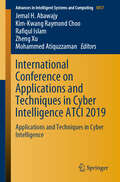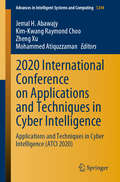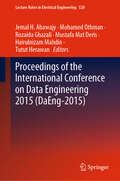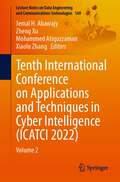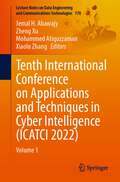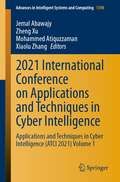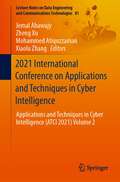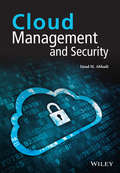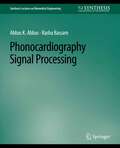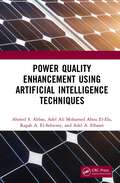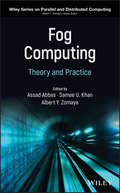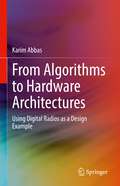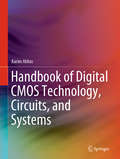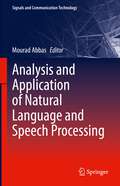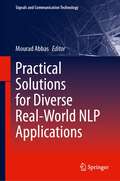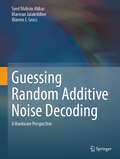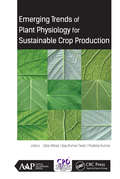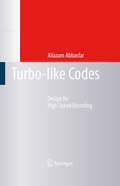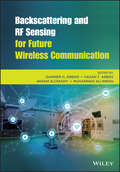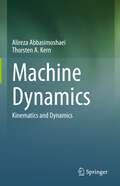- Table View
- List View
International Conference on Applications and Techniques in Cyber Intelligence ATCI 2019: Applications and Techniques in Cyber Intelligence (Advances in Intelligent Systems and Computing #1017)
by Jemal H. Abawajy Kim-Kwang Raymond Choo Rafiqul Islam Zheng Xu Mohammed AtiquzzamanThis book presents innovative ideas, cutting-edge findings, and novel techniques, methods, and applications in a broad range of cybersecurity and cyberthreat intelligence areas. As our society becomes smarter, there is a corresponding need to be able to secure our cyberfuture. The approaches and findings described in this book are of interest to businesses and governments seeking to secure our data and underpin infrastructures, as well as to individual users.
2020 International Conference on Applications and Techniques in Cyber Intelligence: Applications and Techniques in Cyber Intelligence (ATCI 2020) (Advances in Intelligent Systems and Computing #1244)
by Jemal H. Abawajy Kim-Kwang Raymond Choo Zheng Xu Mohammed AtiquzzamanThis book presents innovative ideas, cutting-edge findings, and novel techniques, methods, and applications in a broad range of cybersecurity and cyberthreat intelligence areas. As our society becomes smarter, there is a corresponding need to secure our cyberfuture. The book describes approaches and findings that are of interest to business professionals and governments seeking to secure our data and underpin infrastructures, as well as to individual users.
Proceedings of the International Conference on Data Engineering 2015 (Lecture Notes in Electrical Engineering #520)
by Jemal H. Abawajy Mohamed Othman Rozaida Ghazali Mustafa Mat Deris Hairulnizam Mahdin Tutut HerawanThese proceedings gather outstanding research papers presented at the Second International Conference on Data Engineering 2015 (DaEng-2015) and offer a consolidated overview of the latest developments in databases, information retrieval, data mining and knowledge management. The conference brought together researchers and practitioners from academia and industry to address key challenges in these fields, discuss advanced data engineering concepts and form new collaborations. The topics covered include but are not limited to: • Data engineering • Big data • Data and knowledge visualization • Data management • Data mining and warehousing • Data privacy & security • Database theory • Heterogeneous databases • Knowledge discovery in databases • Mobile, grid and cloud computing • Knowledge management • Parallel and distributed data • Temporal data • Web data, services and information engineering • Decision support systems • E-Business engineering and management • E-commerce and e-learning • Geographical information systems • Information management • Information quality and strategy • Information retrieval, integration and visualization • Information security • Information systems and technologies
Tenth International Conference on Applications and Techniques in Cyber Intelligence: Volume 2 (Lecture Notes on Data Engineering and Communications Technologies #169)
by Jemal H. Abawajy Zheng Xu Mohammed Atiquzzaman Xiaolu ZhangThis book presents innovative ideas, cutting-edge findings, and novel techniques, methods, and applications in a broad range of cybersecurity and cyberthreat intelligence areas. As our society becomes smarter, there is a corresponding need to secure our cyberfuture. The book describes approaches and findings that are of interest to business professionals and governments seeking to secure our data and underpin infrastructures, as well as to individual users.
Tenth International Conference on Applications and Techniques in Cyber Intelligence: Volume 1 (Lecture Notes on Data Engineering and Communications Technologies #170)
by Jemal H. Abawajy Xiaolu Zhang Mohammed Atiquzzaman Zheng XuThis book presents innovative ideas, cutting-edge findings, and novel techniques, methods, and applications in a broad range of cybersecurity and cyberthreat intelligence areas. As our society becomes smarter, there is a corresponding need to secure our cyberfuture. The book describes approaches and findings that are of interest to business professionals and governments seeking to secure our data and underpin infrastructures, as well as to individual users.
2021 International Conference on Applications and Techniques in Cyber Intelligence: Applications and Techniques in Cyber Intelligence (ATCI 2021) Volume 1 (Advances in Intelligent Systems and Computing #1398)
by Jemal Abawajy Zheng Xu Mohammed Atiquzzaman Xiaolu ZhangThis book presents innovative ideas, cutting-edge findings, and novel techniques, methods, and applications in a broad range of cybersecurity and cyberthreat intelligence areas. As our society becomes smarter, there is a corresponding need to secure our cyberfuture. The book describes approaches and findings that are of interest to business professionals and governments seeking to secure our data and underpin infrastructures, as well as to individual users.
2021 International Conference on Applications and Techniques in Cyber Intelligence: Applications and Techniques in Cyber Intelligence (ATCI 2021) Volume 2 (Lecture Notes on Data Engineering and Communications Technologies #81)
by Jemal Abawajy Zheng Xu Mohammed Atiquzzaman Xiaolu ZhangThis book presents innovative ideas, cutting-edge findings, and novel techniques, methods, and applications in a broad range of cybersecurity and cyberthreat intelligence areas. As our society becomes smarter, there is a corresponding need to secure our cyberfuture. The book describes approaches and findings that are of interest to business professionals and governments seeking to secure our data and underpin infrastructures, as well as to individual users. 1. Highlights recent applications and techniques in cyber intelligence2. Includes the proceedings of the 2021 International Conference on Applications and Techniques in Cyber Intelligence (ATCI 2021) 3. Presents a broad range of scientific research on cyber intelligence
Cloud Management and Security
by Imad M. AbbadiWritten by an expert with over 15 years’ experience in the field, this book establishes the foundations of Cloud computing, building an in-depth and diverse understanding of the technologies behind Cloud computing. In this book, the author begins with an introduction to Cloud computing, presenting fundamental concepts such as analyzing Cloud definitions, Cloud evolution, Cloud services, Cloud deployment types and highlighting the main challenges. Following on from the introduction, the book is divided into three parts: Cloud management, Cloud security, and practical examples. Part one presents the main components constituting the Cloud and federated Cloud infrastructure (e.g., interactions and deployment), discusses management platforms (resources and services), identifies and analyzes the main properties of the Cloud infrastructure, and presents Cloud automated management services: virtual and application resource management services. Part two analyzes the problem of establishing trustworthy Cloud, discusses foundation frameworks for addressing this problem – focusing on mechanisms for treating the security challenges, discusses foundation frameworks and mechanisms for remote attestation in Cloud and establishing Cloud trust anchors, and lastly provides a framework for establishing a trustworthy provenance system and describes its importance in addressing major security challenges such as forensic investigation, mitigating insider threats and operation management assurance. Finally, part three, based on practical examples, presents real-life commercial and open source examples of some of the concepts discussed, and includes a real-life case study to reinforce learning – especially focusing on Cloud security. Key Features • Covers in detail two main aspects of Cloud computing: Cloud management and Cloud security • Presents a high-level view (i.e., architecture framework) for Clouds and federated Clouds which is useful for professionals, decision makers, and students • Includes illustrations and real-life deployment scenarios to bridge the gap between theory and practice • Extracts, defines, and analyzes the desired properties and management services of Cloud computing and its associated challenges and disadvantages • Analyzes the risks associated with Cloud services and deployment types and what could be done to address the risk for establishing trustworthy Cloud computing • Provides a research roadmap to establish next-generation trustworthy Cloud computing • Includes exercises and solutions to problems as well as PowerPoint slides for instructors
Cloud Management and Security
by Imad M. AbbadiWritten by an expert with over 15 years’ experience in the field, this book establishes the foundations of Cloud computing, building an in-depth and diverse understanding of the technologies behind Cloud computing. In this book, the author begins with an introduction to Cloud computing, presenting fundamental concepts such as analyzing Cloud definitions, Cloud evolution, Cloud services, Cloud deployment types and highlighting the main challenges. Following on from the introduction, the book is divided into three parts: Cloud management, Cloud security, and practical examples. Part one presents the main components constituting the Cloud and federated Cloud infrastructure (e.g., interactions and deployment), discusses management platforms (resources and services), identifies and analyzes the main properties of the Cloud infrastructure, and presents Cloud automated management services: virtual and application resource management services. Part two analyzes the problem of establishing trustworthy Cloud, discusses foundation frameworks for addressing this problem – focusing on mechanisms for treating the security challenges, discusses foundation frameworks and mechanisms for remote attestation in Cloud and establishing Cloud trust anchors, and lastly provides a framework for establishing a trustworthy provenance system and describes its importance in addressing major security challenges such as forensic investigation, mitigating insider threats and operation management assurance. Finally, part three, based on practical examples, presents real-life commercial and open source examples of some of the concepts discussed, and includes a real-life case study to reinforce learning – especially focusing on Cloud security. Key Features • Covers in detail two main aspects of Cloud computing: Cloud management and Cloud security • Presents a high-level view (i.e., architecture framework) for Clouds and federated Clouds which is useful for professionals, decision makers, and students • Includes illustrations and real-life deployment scenarios to bridge the gap between theory and practice • Extracts, defines, and analyzes the desired properties and management services of Cloud computing and its associated challenges and disadvantages • Analyzes the risks associated with Cloud services and deployment types and what could be done to address the risk for establishing trustworthy Cloud computing • Provides a research roadmap to establish next-generation trustworthy Cloud computing • Includes exercises and solutions to problems as well as PowerPoint slides for instructors
Phonocardiography Signal Processing (Synthesis Lectures on Biomedical Engineering)
by Abbas K. Abbas Rasha BassamThe auscultation method is an important diagnostic indicator for hemodynamic anomalies. Heart sound classification and analysis play an important role in the auscultative diagnosis. The term phonocardiography refers to the tracing technique of heart sounds and the recording of cardiac acoustics vibration by means of a microphone-transducer. Therefore, understanding the nature and source of this signal is important to give us a tendency for developing a competent tool for further analysis and processing, in order to enhance and optimize cardiac clinical diagnostic approach. This book gives the reader an inclusive view of the main aspects in phonocardiography signal processing. Table of Contents: Introduction to Phonocardiography Signal Processing / Phonocardiography Acoustics Measurement / PCG Signal Processing Framework / Phonocardiography Wavelets Analysis / Phonocardiography Spectral Analysis / PCG Pattern Classification / Special Application of Phonocardiography / Phonocardiography Acoustic Imaging and Mapping
Power Quality Enhancement using Artificial Intelligence Techniques
by Ahmed S. Abbas Adel Ali Abou El-Ela Ragab A. El-Sehiemy Adel A. ElbasetThis text discusses sensitivity parametric analysis for the single tuned filter parameters and presents an optimization-based method for solving the allocation problem of the distributed generation units and capacitor banks in distribution systems. It also highlights the importance of artificial intelligence techniques such as water cycle algorithms in solving power quality problems such as over-voltage and harmonic distortion. Features: Presents a sensitivity parametric analysis for the single tuned filter parameters. Discusses optimization-based methods for solving the allocation problem of the distributed generation units and capacitor banks in distribution systems. Highlights the importance of artificial intelligence techniques (water cycle algorithm) for solving power quality problems such as over-voltage and harmonic distortion. Showcases a procedure for harmonic mitigation in active distribution systems using the single tuned harmonic filters. Helps in learning how to determine the optimal planning of the single tuned filters to mitigate the harmonic distortion in distorted systems. It will serve as an ideal reference text for graduate students and academic researchers in the fields of electrical engineering, electronics and communication engineering, Power systems planning and analysis.
Power Quality Enhancement using Artificial Intelligence Techniques
by Ahmed S. Abbas Adel Ali Abou El-Ela Ragab A. El-Sehiemy Adel A. ElbasetThis text discusses sensitivity parametric analysis for the single tuned filter parameters and presents an optimization-based method for solving the allocation problem of the distributed generation units and capacitor banks in distribution systems. It also highlights the importance of artificial intelligence techniques such as water cycle algorithms in solving power quality problems such as over-voltage and harmonic distortion. Features: Presents a sensitivity parametric analysis for the single tuned filter parameters. Discusses optimization-based methods for solving the allocation problem of the distributed generation units and capacitor banks in distribution systems. Highlights the importance of artificial intelligence techniques (water cycle algorithm) for solving power quality problems such as over-voltage and harmonic distortion. Showcases a procedure for harmonic mitigation in active distribution systems using the single tuned harmonic filters. Helps in learning how to determine the optimal planning of the single tuned filters to mitigate the harmonic distortion in distorted systems. It will serve as an ideal reference text for graduate students and academic researchers in the fields of electrical engineering, electronics and communication engineering, Power systems planning and analysis.
Fog Computing: Theory and Practice (Wiley Series on Parallel and Distributed Computing)
by Assad Abbas Samee U. Khan Albert Y. ZomayaSummarizes the current state and upcoming trends within the area of fog computing Written by some of the leading experts in the field, Fog Computing: Theory and Practice focuses on the technological aspects of employing fog computing in various application domains, such as smart healthcare, industrial process control and improvement, smart cities, and virtual learning environments. In addition, the Machine-to-Machine (M2M) communication methods for fog computing environments are covered in depth. Presented in two parts—Fog Computing Systems and Architectures, and Fog Computing Techniques and Application—this book covers such important topics as energy efficiency and Quality of Service (QoS) issues, reliability and fault tolerance, load balancing, and scheduling in fog computing systems. It also devotes special attention to emerging trends and the industry needs associated with utilizing the mobile edge computing, Internet of Things (IoT), resource and pricing estimation, and virtualization in the fog environments. Includes chapters on deep learning, mobile edge computing, smart grid, and intelligent transportation systems beyond the theoretical and foundational concepts Explores real-time traffic surveillance from video streams and interoperability of fog computing architectures Presents the latest research on data quality in the IoT, privacy, security, and trust issues in fog computing Fog Computing: Theory and Practice provides a platform for researchers, practitioners, and graduate students from computer science, computer engineering, and various other disciplines to gain a deep understanding of fog computing.
From Algorithms to Hardware Architectures: Using Digital Radios as a Design Example
by Karim AbbasThis book uses digital radios as a challenging design example, generalized to bridge a typical gap between designers who work on algorithms and those who work to implement those algorithms on silicon. The author shows how such a complex system can be moved from high-level characterization to a form that is ready for hardware implementation. Along the way, readers learn a lot about how algorithm designers can benefit from knowing the hardware they target and how hardware designers can benefit from a familiarity with the algorithm. The book shows how a high-level description of an algorithm can be migrated to a fixed-point block diagram with a well-defined cycle accurate architecture and a fully documented controller. This can significantly reduce the length of the hardware design cycle and can improve its outcomes. Ultimately, the book presents an explicit design flow that bridges the gap between algorithm design and hardware design.Provides a guide to baseband radio design for Wi-Fi and cellular systems, from an implementation-focused, perspective;Explains how arithmetic is moved to hardware and what the cost of each operation is in terms of delay, area and power;Enables strategic architectural decisions based on the algorithm, available processing units and design requirements.
Handbook of Digital CMOS Technology, Circuits, and Systems
by Karim AbbasThis book provides a comprehensive reference for everything that has to do with digital circuits. The author focuses equally on all levels of abstraction. He tells a bottom-up story from the physics level to the finished product level. The aim is to provide a full account of the experience of designing, fabricating, understanding, and testing a microchip. The content is structured to be very accessible and self-contained, allowing readers with diverse backgrounds to read as much or as little of the book as needed. Beyond a basic foundation of mathematics and physics, the book makes no assumptions about prior knowledge. This allows someone new to the field to read the book from the beginning. It also means that someone using the book as a reference will be able to answer their questions without referring to any external sources.
Analysis and Application of Natural Language and Speech Processing (Signals and Communication Technology)
by Mourad AbbasThis book presents recent advances in NLP and speech technology, a topic attracting increasing interest in a variety of fields through its myriad applications, such as the demand for speech guided touchless technology during the Covid-19 pandemic. The authors present results of recent experimental research that provides contributions and solutions to different issues related to speech technology and speech in industry. Technologies include natural language processing, automatic speech recognition (for under-resourced dialects) and speech synthesis that are useful for applications such as intelligent virtual assistants, among others. Applications cover areas such as sentiment analysis and opinion mining, Arabic named entity recognition, and language modelling. This book is relevant for anyone interested in the latest in language and speech technology.
Practical Solutions for Diverse Real-World NLP Applications (Signals and Communication Technology)
by Mourad AbbasThis book unveils the most advanced techniques and innovative applications in the natural language processing (NLP) field. It uncovers the secrets to enhancing language understanding, and presents practical solutions to different NLP tasks, as text augmentation, paraphrase generation, and restoring spaces and punctuation in multiple languages. It unlocks the potential of hierarchical multi-task learning for cross-lingual phoneme recognition, and allows readers to explore more real-world applications such as error correction, aggregating industrial security findings as well as predicting music emotion values from social media conversations. "Practical Solutions for Diverse Real-World NLP Applications" is the suitable guidebook for researchers, students, and practitioners as it paves the way for them by delivering invaluable insights and knowledge.
Guessing Random Additive Noise Decoding: A Hardware Perspective
by Syed Mohsin Abbas Marwan Jalaleddine Warren J. GrossThis book gives a detailed overview of a universal Maximum Likelihood (ML) decoding technique, known as Guessing Random Additive Noise Decoding (GRAND), has been introduced for short-length and high-rate linear block codes. The interest in short channel codes and the corresponding ML decoding algorithms has recently been reignited in both industry and academia due to emergence of applications with strict reliability and ultra-low latency requirements . A few of these applications include Machine-to-Machine (M2M) communication, augmented and virtual Reality, Intelligent Transportation Systems (ITS), the Internet of Things (IoTs), and Ultra-Reliable and Low Latency Communications (URLLC), which is an important use case for the 5G-NR standard. GRAND features both soft-input and hard-input variants. Moreover, there are traditional GRAND variants that can be used with any communication channel, and specialized GRAND variants that are developed for a specific communication channel. This book presents a detailed overview of these GRAND variants and their hardware architectures. The book is structured into four parts. Part 1 introduces linear block codes and the GRAND algorithm. Part 2 discusses the hardware architecture for traditional GRAND variants that can be applied to any underlying communication channel. Part 3 describes the hardware architectures for specialized GRAND variants developed for specific communication channels. Lastly, Part 4 provides an overview of recently proposed GRAND variants and their unique applications.This book is ideal for researchers or engineers looking to implement high-throughput and energy-efficient hardware for GRAND, as well as seasoned academics and graduate students interested in the topic of VLSI hardware architectures. Additionally, it can serve as reading material in graduate courses covering modern error correcting codes and Maximum Likelihood decoding for short codes.
Emerging Trends of Plant Physiology for Sustainable Crop Production
by Zafar Abbas Ajay Kumar Tiwari Pradeep KumarPlant physiology is now considered as an essential ingredient for improving crop productivity, a continuing necessity with today’s ever-increasing world population. This new volume provides an understanding of the physiological basis of the various plant processes and their underlying mechanisms under fluctuating environments, which is of great importance for sustainable crop production. Further advances in cellular and molecular biology hold promise to modify physiological processes, thereby improving the quality and quantity of major food crops and ensuring stability in yield of the produce even under severe abiotic stress. This book covers the latest information on the physiological basis of plant productivity, including abiotic stress adaptation and management, plant nutrition, climate change and plant productivity, transgenic and functional genomics, and plant growth regulators and their applications. The chapters in this volume tackle some of these key issues of sustainable plant production and evolve future strategies in overcoming challenges faced by the agricultural sector as a whole. The topics covered in this book presents important from research reputed scientists. This volume is a rich source of information in one place. It will be a useful resource for researchers and extension workers involved in plant physiology and related disciplines. Key features: Provide the latest information on developments in plant physiology Covers abiotic and biotic stress on economically important crop species Presents a detailed collection of biotechnological approaches in plant physiology Covers plant growth regulators, secondary metabolites, germination, crop growth and development of different crop species Provides research from experts at internationally renowned institutes
Emerging Trends of Plant Physiology for Sustainable Crop Production
by Zafar Abbas Ajay Kumar Tiwari Pradeep KumarPlant physiology is now considered as an essential ingredient for improving crop productivity, a continuing necessity with today’s ever-increasing world population. This new volume provides an understanding of the physiological basis of the various plant processes and their underlying mechanisms under fluctuating environments, which is of great importance for sustainable crop production. Further advances in cellular and molecular biology hold promise to modify physiological processes, thereby improving the quality and quantity of major food crops and ensuring stability in yield of the produce even under severe abiotic stress. This book covers the latest information on the physiological basis of plant productivity, including abiotic stress adaptation and management, plant nutrition, climate change and plant productivity, transgenic and functional genomics, and plant growth regulators and their applications. The chapters in this volume tackle some of these key issues of sustainable plant production and evolve future strategies in overcoming challenges faced by the agricultural sector as a whole. The topics covered in this book presents important from research reputed scientists. This volume is a rich source of information in one place. It will be a useful resource for researchers and extension workers involved in plant physiology and related disciplines. Key features: Provide the latest information on developments in plant physiology Covers abiotic and biotic stress on economically important crop species Presents a detailed collection of biotechnological approaches in plant physiology Covers plant growth regulators, secondary metabolites, germination, crop growth and development of different crop species Provides research from experts at internationally renowned institutes
Turbo-like Codes: Design for High Speed Decoding
by Aliazam AbbasfarThis book introduces turbo error correcting concept in a simple language, including a general theory and the algorithms for decoding turbo-like code. It presents a unified framework for the design and analysis of turbo codes and LDPC codes and their decoding algorithms. A major focus is on high speed turbo decoding, which targets applications with data rates of several hundred million bits per second (Mbps).
Backscattering and RF Sensing for Future Wireless Communication
by Qammer H AbbasiDiscover what lies ahead in wireless communication networks with this insightful and forward-thinking book written by experts in the field Backscattering and RF Sensing for Future Wireless Communication delivers a concise and insightful picture of emerging and future trends in increasing the efficiency and performance of wireless communication networks. The book shows how the immense challenge of frequency saturation could be met via the deployment of intelligent planar electromagnetic structures. It provides an in-depth coverage of the fundamental physics behind these structures and assesses the enhancement of the performance of a communication network in challenging environments, like densely populated urban centers. The distinguished editors have included resources from a variety of leading voices in the field who discuss topics like the engineering of metasurfaces at a large scale, the electromagnetic analysis of planar metasurfaces, and low-cost and reliable backscatter communication. All of the included works focus on the facilitation of the development of intelligent systems designed to enhance communication network performance. Readers will also benefit from the inclusion of: A thorough introduction to the evolution of wireless communication networks over the last thirty years, including the imminent saturation of the frequency spectrum An exploration of state-of-the-art techniques that next-generation wireless networks will likely incorporate, including software-controlled frameworks involving artificial intelligence An examination of the scattering of electromagnetic waves by metasurfaces, including how wave propagation differs from traditional bulk materials A treatment of the evolution of artificial intelligence in wireless communications Perfect for researchers in wireless communications, electromagnetics, and urban planning, Backscattering and RF Sensing for Future Wireless Communication will also earn a place in the libraries of government policy makers, technologists, and telecom industry stakeholders who wish to get a head start on understanding the technologies that will enable tomorrow's wireless communications.
Backscattering and RF Sensing for Future Wireless Communication
by Qammer H. Abbasi Hasan Tahir Abbas Akram Alomainy Muhammad Ali ImranDiscover what lies ahead in wireless communication networks with this insightful and forward-thinking book written by experts in the field Backscattering and RF Sensing for Future Wireless Communication delivers a concise and insightful picture of emerging and future trends in increasing the efficiency and performance of wireless communication networks. The book shows how the immense challenge of frequency saturation could be met via the deployment of intelligent planar electromagnetic structures. It provides an in-depth coverage of the fundamental physics behind these structures and assesses the enhancement of the performance of a communication network in challenging environments, like densely populated urban centers. The distinguished editors have included resources from a variety of leading voices in the field who discuss topics like the engineering of metasurfaces at a large scale, the electromagnetic analysis of planar metasurfaces, and low-cost and reliable backscatter communication. All of the included works focus on the facilitation of the development of intelligent systems designed to enhance communication network performance. Readers will also benefit from the inclusion of: A thorough introduction to the evolution of wireless communication networks over the last thirty years, including the imminent saturation of the frequency spectrum An exploration of state-of-the-art techniques that next-generation wireless networks will likely incorporate, including software-controlled frameworks involving artificial intelligence An examination of the scattering of electromagnetic waves by metasurfaces, including how wave propagation differs from traditional bulk materials A treatment of the evolution of artificial intelligence in wireless communications Perfect for researchers in wireless communications, electromagnetics, and urban planning, Backscattering and RF Sensing for Future Wireless Communication will also earn a place in the libraries of government policy makers, technologists, and telecom industry stakeholders who wish to get a head start on understanding the technologies that will enable tomorrow's wireless communications.
Biogas Energy (SpringerBriefs in Environmental Science #2)
by Tasneem Abbasi S.M. Tauseef S.A. AbbasiIn recent years, the importance of biogas energy has risen manifold and has become universal. This is due to the realization that biogas capture and utilization has great potential in controlling global warming. By capturing biogas wherever it is formed, we not only tap a source of clean energy, but we also prevent the escape of methane to the atmosphere. Given that methane has 25 times greater global warming potential than CO2, methane capture through biogas energy in this manner can contribute substantially towards global warming control.
Machine Dynamics: Kinematics and Dynamics
by Alireza Abbasimoshaei Thorsten A. KernIn this book, we aim to give a thorough introduction to machine dynamics. It covers the theoretical basis of dynamics, modelling, mechanical design, practical applications, kinematics and kinetics, principles of mechanics, equations of motion for multibody systems, applications to mechanisms, vehicle dynamics, and static and dynamic balancing. It covers a complete range of mechanisms and concepts, from the determination of degrees of freedom to the design of complex cams. This progression is explained at a reasonable pace so that by the end the reader is able to design and analyze mechanical systems. Throughout the book, we also try to introduce conceptual examples and exercises to make the text more practical and understandable for the reader and also useful as a reference for lectures in universities. In addition, most books in this field are too voluminous and therefore are not suitable as a reference for a lecture. In this book, we have reduced the unnecessary theory part and put more emphasis on practical examples. Moreover, it is written in such a way that it will guide the readers even if they have forgotten the dynamics and basic concept and provide enough information. So this book can be used as a self-study book.
